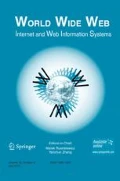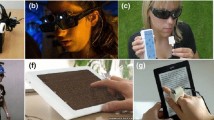Abstract
The Web 2.0 sees once static pages evolve into hybrid applications, and content that was previously simple, now becoming increasingly complicated due to the many updating components located throughout the page. While beneficial for some users, these components (widgets) are often complex and will lead to confusion and frustration for others, notably those for whom accessibility is already an issue. While users and developers often perceive widgets as complete components (a Slideshow, or an Auto Suggest List), they are in-fact heterogeneous collections of code, and are therefore hard to computationally identify. Identification is critical if we wish to reverse engineer inaccessible widgets or ‘inject’ missing ‘WAI-ARIA’ into ‘RIAs’. In this case, we introduce a technique that analyses the code associated with a Web page to identify widgets using combinations of code constructs which enable uniquely identification. We go on to technically evaluate our approach with the most difficult widgets to distinguish between—Slideshows and Carousels—and then describe two prototype applications for visually impaired and older users by means of example.
Similar content being viewed by others
References
Asakawa, C., Itoh, T.: User interface of a home page reader. In: ASSETS ’98: Proceedings of the Third International ACM Conference on Assistive Technologies, pp. 149–156. ACM, New York (1998). doi:10.1145/274497.274526
Brown, A., Jay, C.: A review of assistive technologies: can users access dynamically updating information? SASWAT Technical Report 2, The University of Manchester, School of Computer Science, UK (2008). doi:http://wel-eprints.cs.manchester.ac.uk/70/
Brown, A., Jay, C., Harper, S.: Audio presentation of auto-suggest lists. In: W4A ’09: Proceedings of the 2009 International Cross-Disciplinary Conference on Web Accessibility (W4A), pp. 58–61. ACM, New York (2009). doi:10.1145/1535654.1535667
Brown, A., Jay, C., Harper, S.: Audio access to calendars. In: W4A 2010: Proceedings of the 2010 International Cross-Disciplinary Conference on Web Accessibility (W4A). ACM, New York (2010). doi:http://dl.acm.org/citation.cfm?doid=1805986.1806028
Carmi, R., Itti, L.: Causal saliency effects during natural vision. In: ETRA ’06: Proceedings of the 2006 Symposium on Eye Tracking Research & Applications, pp. 11–18. ACM, New York (2006). doi:10.1145/1117309.0410. URL: http://portal.acm.org/citation.cfm?id=1117309.0410
Chen, A.Q.: Widget identification and modification for web 2.0 access technologies (WIMWAT). SIGACCESS Access. Comput., pp. 11–18 (2010). doi:10.1145/1731849.1731851
Chen, A.Q.: Profiling the web page’s behaviour layer. WIMWAT Technical Report 5, The University of Manchester, School of Computer Science, UK (2011). http://wel-eprints.cs.manchester.ac.uk/135/
Chen, A.Q., Harper, S.: Identifying web widgets. WIMWAT Technical Report 1, The University of Manchester, School of Computer Science, UK (2009). http://wel-eprints.cs.manchester.ac.uk/115/
Chen, C.L., Raman, T.V.: AxsJAX: a talking translation bot using google im: bringing web-2.0 applications to life. In: Proceedings of the 2008 International Cross-Disciplinary Conference on Web Accessibility (W4A), W4A ’08, pp. 54–56. ACM, New York (2008). doi:10.1145/1368044.1368056
Craig, J., Cooper, M., Pappas, L., Schwerdtfeger, R., Seeman, L.: Accessible Rich Internet Applications (WAI-ARIA) 1.0. http://www.w3.org/TR/wai-aria/ (2009)
Dixon, M., Leventhal, D., Fogarty, J.: Content and hierarchy in pixel-based methods for reverse engineering interface structure. In: Proceedings of the 2011 Annual Conference on Human Factors in Computing Systems, CHI ’11, pp. 969–978. ACM, New York (2011). doi:10.1145/1978942.1979086
Dong, J., Sun, Y., Zhao, Y.: Design pattern detection by template matching. In: SAC ’08: Proceedings of the 2008 ACM symposium on Applied Computing, pp. 765–769. ACM, New York (2008). doi:http://dl.acm.org/citation.cfm?doid=1363686.1363864
Fukaya, K., Kubo, A., Washizaki, H., Fukazawa, Y.: Design pattern detection using source code of before applying design patterns. In: 1st International Workshop on Software Patterns and Quality (2007)
Gamma, E., Helm, R., Johnson, R., Vlissides, J.: Design Patterns: Elements of Reusable Object-Oriented Software. Addison-Wesley, Reading (1995)
Hailpern, J., Reid, L.G., Boardman, R., Annam, S.: Web 2.0: blind to an accessible new world. In: WWW ’09: Proceedings of the 18th International Conference on World Wide Web, pp. 821–830. ACM, New York (2009). doi:http://dl.acm.org/citation.cfm?doid=1526709.1526820
Hanson, V.L.: Age and web access: the next generation. In: W4A ’09: Proceedings of the 2009 International Cross-Disciplinary Conference on Web Accessibility (W4A), pp. 7–15. ACM, New York (2009). doi:10.1145/1535654.1535658
Hanson, V.L., Richards, J.T.: Achieving a more usable World Wide Web. Behav. Inf. Technol. 24(3), 231–246 (2005). doi:10.1080/01449290412331327465
Hartley, A.A.: Attention. In: Craik, F.I., Salthouse, T.A. (eds.) The Handbook of Aging and Cognition, chap. 1, pp. 3–53. Laurence Erlbaum Associates (1992). ISBN: 0–8058-0713-6
Jay, C., Brown, A., Harper, S.: Internal evaluation of the SASWAT audio browser. SASWAT Technical Report 6, The University of Manchester, School of Computer Science, UK (2010). doi:http://wel-eprints.cs.manchester.ac.uk/125/
Kurniawan, S., King, A., Evans, D., Blenkhorn, P.: Personalising web page presentation for older people. Interact. Comput. 18(3), 457–477 (2006). doi:10.1016/j.intcom.2005.11.006. URL: http://www.sciencedirect.com/science/article/B6V0D-4HYMY31-6/2/0c620c176c9eed3ef2acc2d287de3e9a. Human Factors in Personalised Systems and Services
Lunn, D., Harper, S.: Using galvanic skin response measures to identify areas of frustration for older web 2.0 users. In: W4A ’10: Proceedings of the 2010 International Cross-Disciplinary Conference on Web Accessibility (W4A). ACM, New York (2010). doi:http://dl.acm.org/citation.cfm?doid=1805986.1806032
Memmert, D.: The effects of eye movements, age, and expertise on inattentional blindness. Conscious. Cogn. 15(3), 620–627 (2006). doi:10.1016/j.concog.2006.01.001. URL: http://www.sciencedirect.com/science/article/B6WD0-4J91R6C-1/2/764cb264eedae395b41d0a9cc7cb9ad9
Miyashita, H., Sato, D., Takagi, H., Asakawa, C.: Aibrowser for multimedia: introducing multimedia content accessibility for visually impaired users. In: Assets ’07: Proceedings of the 9th International ACM SIGACCESS Conference on Computers and Accessibility, pp. 91–98. ACM, New York (2007). doi:10.1145/1296843.1296860
Sàenz, M., Buracas, G.T., Boynton, G.M.: Global feature-based attention for motion and color. Vis. Res. 43(6), 629–637 (2003). doi:10.1016/S0042-6989(02)00595-3. URL: http://www.sciencedirect.com/science/article/B6T0W-47XSSK6-1/2/b540ce8624f967c247b3e30a4e2ad97f
Thiessen, P., Chen, C.: Ajax live regions: chat as a case example. In: W4A ’07: Proceedings of the 2007 International Cross-Disciplinary Conference on Web Accessibility (W4A), pp. 7–14. ACM, New York (2007). doi:http://dl.acm.org/citation.cfm?doid=1243441.1243450
Varakin, D.A., Levin, D.T.: Change blindness and visual memory: visual representations get rich and act poor. Br. J. Psychol. 97(1), 51–77 (2006). doi:10.1348/000712605X68906. URL: http://www.ingentaconnect.com/content/bpsoc/bjp/2006/00000097/00000001/art00004
Author information
Authors and Affiliations
Corresponding author
Rights and permissions
About this article
Cite this article
Chen, A.Q., Harper, S., Lunn, D. et al. Widget Identification: A High-Level Approach to Accessibility. World Wide Web 16, 73–89 (2013). https://doi.org/10.1007/s11280-012-0156-6
Received:
Revised:
Accepted:
Published:
Issue Date:
DOI: https://doi.org/10.1007/s11280-012-0156-6




